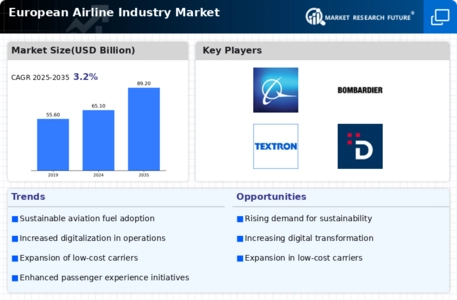Regulatory Framework
The regulatory landscape significantly influences the Global European Airline Industry Market. Governments across Europe are implementing policies aimed at ensuring safety, security, and environmental sustainability within the aviation sector. Compliance with these regulations often requires airlines to invest in new technologies and practices, which can impact operational costs. However, a well-structured regulatory framework can also foster competition and innovation, ultimately benefiting consumers. As regulations continue to evolve, airlines must adapt to maintain compliance while striving to enhance their service offerings, which could lead to a more dynamic market environment.
Rising Passenger Demand
The Global European Airline Industry Market experiences a notable increase in passenger demand, driven by factors such as economic growth and rising disposable incomes. In 2024, the market is valued at 65.1 USD Billion, reflecting a robust recovery in travel preferences. This trend is particularly evident in leisure travel, with many individuals eager to explore new destinations. The European market is characterized by a diverse range of airlines catering to various segments, from budget carriers to premium services. As consumer confidence continues to grow, the demand for air travel is expected to remain strong, propelling the market forward.
Market Growth Projections
The Global European Airline Industry Market is poised for growth, with projections indicating a compound annual growth rate (CAGR) of 2.9% from 2025 to 2035. This growth trajectory suggests a steady recovery and expansion of air travel demand across Europe. Factors contributing to this growth include increasing globalization, rising tourism, and enhanced connectivity between major cities. As airlines adapt to changing consumer preferences and invest in modernizing their fleets, the market is likely to witness a transformation that aligns with future travel trends. This positive outlook underscores the resilience and potential of the European airline sector.
Sustainability Initiatives
Sustainability has emerged as a critical driver within the Global European Airline Industry Market. Airlines are increasingly prioritizing eco-friendly practices to reduce their carbon footprint and meet regulatory standards. Initiatives such as the use of sustainable aviation fuels and investment in fuel-efficient aircraft are gaining traction. This shift towards sustainability is not only a response to environmental concerns but also aligns with consumer preferences for responsible travel. As the industry moves towards a greener future, the market is expected to evolve, with airlines potentially achieving significant reductions in emissions, thereby enhancing their competitive positioning.
Technological Advancements
Technological innovations play a pivotal role in shaping the Global European Airline Industry Market. Airlines are increasingly adopting advanced technologies to enhance operational efficiency and improve customer experience. Innovations such as artificial intelligence, big data analytics, and automation are being integrated into various processes, from ticketing to baggage handling. These advancements not only streamline operations but also contribute to cost savings and improved safety measures. As airlines invest in modernizing their fleets and adopting sustainable practices, the market is likely to witness a transformation that aligns with evolving consumer expectations and regulatory requirements.
Market Consolidation Trends
Market consolidation trends are shaping the Global European Airline Industry Market, as airlines seek to enhance their competitive edge through mergers and acquisitions. This consolidation allows for increased operational efficiencies, expanded route networks, and improved financial stability. As the market is projected to grow to 89.2 USD Billion by 2035, airlines are likely to pursue strategic partnerships to capture a larger share of the market. While consolidation can lead to reduced competition in some areas, it may also result in improved services and lower fares for consumers, as airlines streamline operations and leverage economies of scale.








Leave a Comment